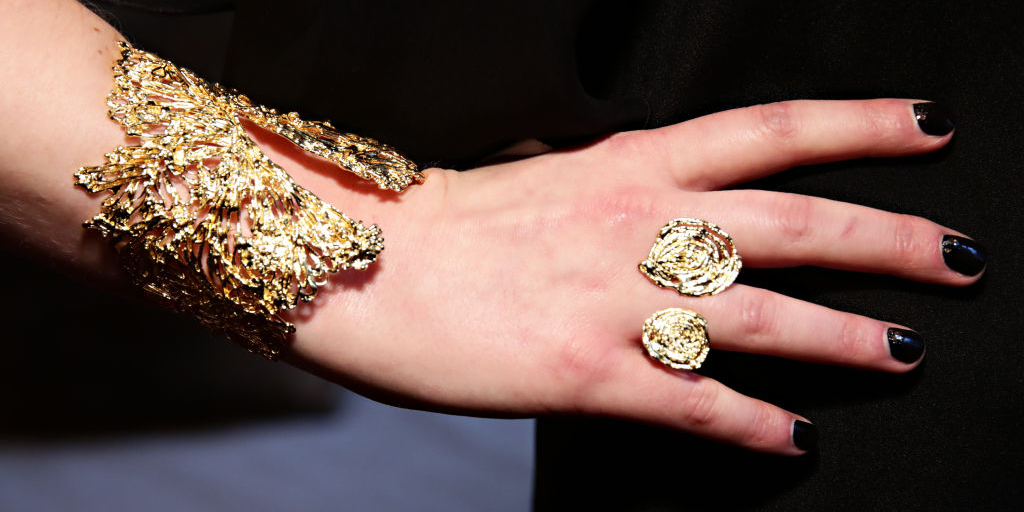- Gold has soared this year, putting a squeeze on jewelers’ prices and gross margins.
- Smaller companies like Automic Gold, a fine jeweler in New York, may pass costs to consumers. Larger companies like Tiffany & Co. are more likely to see gross margins take a hit.
- Recycle markets for jewelry are booming as consumers look to cash out gold assets.
- Read more on Business Insider.
Al Sandimirova checks the price of gold every single day.
Sandimirova runs Automic Gold, a sustainable jewelry company based in New York, with their wife, Kira. Because they specialize in fine jewelry, the price of gold is extremely important to their business model, they told Markets Insider in an interview.
This year, the price of gold has skyrocketed as much as 20%, hitting a peak of $1,549 per ounce in September. As recession fears mount amid global uncertainty, investors have piled into gold, long known as a safe-haven asset. This has pushed up the price and changed the game for the jewelry industry, which uses gold as a commodity material instead of a commodity asset.
Automic Gold decided that to offset the increased cost of the material, it would raise prices on its jewelry by roughly 30% across the board.
"As a small business owner, I'm always nervous to raise prices," Sandimirova told Markets Insider in an interview. But, Sandimirova needed to buy more gold at some point in the future, and they worried they wouldn't be able to purchase enough material to meet demand without a price increase.
At first, sales took a nosedive after Automic Gold made its broad price increase. Luckily, when Sandimirova took to social media to explain the bump in jewelry prices, sales returned to their normal average, they said, showing that consumers are willing to pay higher prices for fine goods and companies with sustainable values right now.
Traditional companies take the hit in gross margins
While smaller companies like Automic Gold may pass increased commodity prices along to consumers, larger companies may opt to keep prices stable instead. Traditional jewelers such as Tiffany & Co. and Signet Jewelers have a greater ability to take the hit in gross margins and keep prices stable for consumers.
But the effect on gross margins can be significant, according to analyst calculations. For example, Tiffany & Co.'s commodity cost is 50% diamonds and gemstones, 25% silver, 15% gold, and 10% platinum, according to a September 2018 note from Oliver Chen, a retail analyst at Cowen.
If the price of any of those materials increased, it could hit cost of goods sold, or COGS, according to Chen, though he'd typically expect a three- to five-quarter lag for changes in costs to impact margins.
Chen calculated that for Tiffany's, for every 1% increase in material cost, gross margins could decline by 20 basis points. By that math, a 20% increase in the price of gold could have a 400-basis-point hit to gross margins.
The recycling and reselling market is booming
On the flip side, some companies have seen a benefit from the booming price of gold. There's been a surge in the recycle and resale market for fine jewelry this year, according to Benny De Kalo, the founder and CEO of Worthy, a luxury goods marketplace.
"As the gold price goes up people think it's time to sell," De Kalo told Markets Insider in an interview. As recession risks have increased, consumers are looking to liquidate some of their fine gold jewelry, De Kalo said. While Worthy has seen 100% yearly growth over the last five years, that's increased in 2019, De Kalo told Markets Insider.
De Kalo also said that Worthy has seen an uptick in demand for recycled diamonds as the price of rough diamonds has bottomed out due to a glut in supply that's made it difficult to make money from new diamonds and put a premium on reused ones. DeBeers' new diamond sales dropped 39% on the year for the same reason.
The link between gold and diamonds
While the oversupply in rough diamonds is due to a number of reasons, there's a fuzzy link between climbing gold prices and falling diamond prices, according to a September note from Citigroup analyst Barry Ehrlich.
The note explains that diamonds don't hold value as well as gold, which is a safe-haven asset, so during times of recession risk or consumer fear, gold tends to trend up and diamonds down.
The last time gold prices were elevated for a prolonged period, in 2011 to 2012, gold recycling increased and reached about 36% of the total world supply, according to Ehrlich. This included increased levels of diamond recycling, he said.
There could be more of the same ahead. "If economic conditions deteriorate, we should expect not only subdued demand but additional diamond supply from recycling," Ehrlich wrote.

